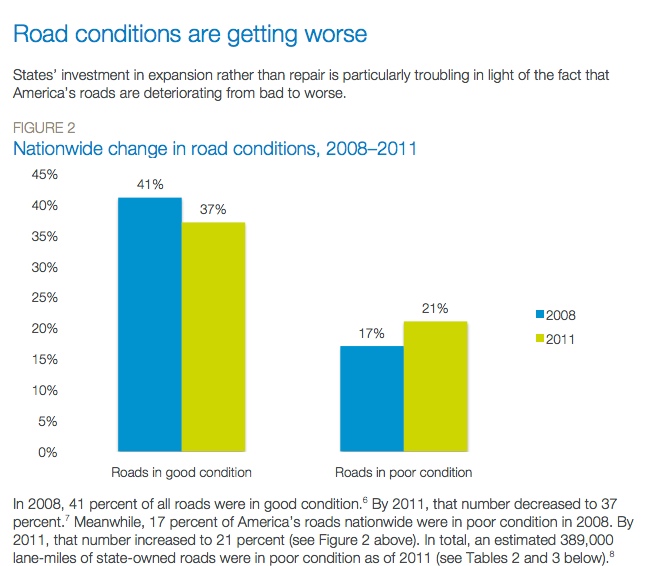Pennsylvania spends more on new road expansion than we do on maintaining our existing network – despite financial liabilities mounting & conditions not improving. Meanwhile, we just raised the gas tax.
Here is a link to an eye opening study by Smart Growth America and Taxpayers for Common sense.
State departments of transportation (DOTs) are spending more money building new roads than maintaining the ones they have—despite the fact that roads are crumbling, financial liabilities are mounting and conditions are not improving for America’s drivers.
-Executive Summary
Here’s the statistical breakdown for PA:
*dollar figures in millions

Average annual state expenditures on road expansion versus repair, 2009–2011 From “Repair Priorities 2014 Transportation spending strategies to save taxpayer dollars and improve roads.
So we have above representing Pennsylvania’s most recent spending reality. (Again remember, we just raised gas taxes to address a “crisis” level concern. Which of course is pretty much universally acknowledged as a band-aid at best.) This in my opinion is a problem in and of itself, but meanwhile here are the results of this failed strategy…
Here is another little tidbit from the report PA specific:
Pennsylvania as stated above is spending 877 million a year in repair. What’s the liability? 2,203 million. That’s a deficiency of 1,326 million annually.
Pennsylvania reflects the Nationwide trend of spending billions for marginal benefit. “States spent $20.4 billion on road expansion each year between 2009 and 2011. During that time our state-owned road network increased by 8,822 lane-miles, less than 1 percent. Meanwhile, America’s driving measured in vehicle-miles traveled, remained fairly stable during this two-year period, yet traffic congestion in urban areas did not change. It’s a statistical fact: States’ investments in expansion are yielding little gain for drivers despite the substantial cost.”
My question is whose going take some leadership in Pennsylvania? Road conditions are deteriorating yet our spending problems are focused on expansion which at best provide negligible results in level of service improvements. Whose going to break the broken cycle?
I’m looking towards our local state officials for leadership here. @Senator Pat Browne, @Representative Ryan Mackenzie, @Representative Justin Simmons, @Representative Michael Schlossberg (House transportation committee). Anyone paying attention to this?






